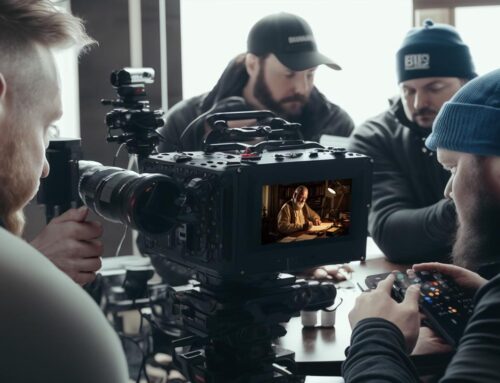The digital landscape is a battleground for attention, where creators and brands compete for views, likes, shares, and comments. This competition has given rise to the concept of viral content – a piece of content that rapidly spreads across the internet, garnering millions of views, likes, and shares in a short period. The allure of virality is irresistible. It promises instant fame, brand recognition, and possibly, substantial monetary gain.
However, while viral content can provide a quick burst of attention, it is not a reliable or sustainable strategy for building an engaged audience over the long term. Relying on virality is like betting on a lottery; it’s unpredictable, uncontrollable, and often short-lived. A video may go viral one day and then be forgotten the next.
This article, “Beyond Virality: Crafting Video Content for Consistent Engagement,” seeks to provide a comprehensive guide for creators and brands looking to move beyond the virality trap. Instead of chasing the elusive viral hit, we will focus on strategies and techniques to craft compelling video content that consistently engages audiences and fosters long-term loyalty.
From understanding the nature of engagement to exploring the psychology of shareability, from dissecting the elements of compelling storytelling to diving into the data-driven world of content optimization, we will cover a broad spectrum of topics essential to the art and science of creating engaging video content.
By the end of this article, readers will have a well-rounded understanding of how to design video content strategies that prioritize consistent engagement over fleeting virality. They will also gain insights into various tools and techniques that can help measure and enhance audience engagement. Let’s dive in.
Table of Contents
- Understanding Engagement
- The Psychology of Shareability
- Storytelling: The Heart of Engagement
- Optimizing Content for Engagement
- Measuring Engagement
- Enhancing Engagement
- Final Thoughts
- Sources
Understanding Engagement
Engagement in the context of digital content, especially video content, is a measure of how deeply and consistently your audience interacts with your creations. This interaction could take the form of likes, comments, shares, and, most importantly, watch time. However, engagement is not just about these visible metrics; it’s also about the invisible connection that your audience feels with your content and, by extension, with you or your brand.
Understanding engagement starts with recognizing that every piece of content you create is a conversation with your audience. When viewers watch your video, they’re taking time out of their day to listen to what you have to say. When they like or share your video, they’re responding to your content in agreement or appreciation. When they comment on your video, they’re continuing the conversation, adding their thoughts, opinions, or feedback. This two-way interaction between the creator and the viewer is at the heart of engagement.
Engagement is crucial because it’s an indication of the depth of the relationship between the creator or brand and the audience. High engagement usually signifies a deep connection, as the audience finds enough value in the content to interact with it and come back for more. This is why highly engaged audiences are more likely to turn into loyal fans or customers, contributing to long-term success.
However, creating consistently engaging content is not an easy task. It requires a deep understanding of your audience’s interests, needs, and preferences. You need to know what kind of content resonates with your audience, what triggers their emotions, what adds value to their lives, and what motivates them to share your content with others.
Moreover, engagement is not a static state but a dynamic process. Audiences evolve, trends change, and the digital landscape shifts. Therefore, understanding engagement also means being adaptive and responsive to these changes. You need to continuously learn from your audience, experiment with new ideas, measure the impact, and adjust your strategy accordingly.
In essence, understanding engagement is about recognizing that your audience is not just a set of statistics, but a community of individuals with diverse interests and needs. Your task, as a creator or brand, is to create content that starts meaningful conversations, adds value, and builds a deep, lasting connection with this community. This is the key to consistent engagement and long-term success in the digital landscape.
Engagement in the context of digital content, especially video content, is a measure of how deeply and consistently your audience interacts with your creations. This interaction could take the form of likes, comments, shares, and, most importantly, watch time. However, engagement is not just about these visible metrics; it’s also about the invisible connection that your audience feels with your content and, by extension, with you or your brand.
Understanding engagement starts with recognizing that every piece of content you create is a conversation with your audience. When viewers watch your video, they’re taking time out of their day to listen to what you have to say. When they like or share your video, they’re responding to your content in agreement or appreciation. When they comment on your video, they’re continuing the conversation, adding their thoughts, opinions, or feedback. This two-way interaction between the creator and the viewer is at the heart of engagement.
Engagement is crucial because it’s an indication of the depth of the relationship between the creator or brand and the audience. High engagement usually signifies a deep connection, as the audience finds enough value in the content to interact with it and come back for more. This is why highly engaged audiences are more likely to turn into loyal fans or customers, contributing to long-term success.
However, creating consistently engaging content is not an easy task. It requires a deep understanding of your audience’s interests, needs, and preferences. You need to know what kind of content resonates with your audience, what triggers their emotions, what adds value to their lives, and what motivates them to share your content with others.
Moreover, engagement is not a static state but a dynamic process. Audiences evolve, trends change, and the digital landscape shifts. Therefore, understanding engagement also means being adaptive and responsive to these changes. You need to continuously learn from your audience, experiment with new ideas, measure the impact, and adjust your strategy accordingly.
In essence, understanding engagement is about recognizing that your audience is not just a set of statistics, but a community of individuals with diverse interests and needs. Your task, as a creator or brand, is to create content that starts meaningful conversations, adds value, and builds a deep, lasting connection with this community. This is the key to consistent engagement and long-term success in the digital landscape.
The Psychology of Shareability
The psychology of shareability revolves around understanding why and when people decide to share content with others. This fundamental understanding can guide creators in crafting content that is more likely to be shared, thereby extending its reach and enhancing its engagement.
Emotional Connection
One of the most powerful drivers of shareability is the emotional response elicited by a piece of content. Studies have found that content that triggers strong emotional reactions, whether positive (like joy, awe, and amusement) or negative (like anger, fear, or sadness), is more likely to be shared. For instance, content that makes people laugh or marvel at something can often become highly shareable because of the positive emotions associated with it.
Informational Value
People also tend to share content that they believe holds value for others in their network. This could be a tutorial video, a thought-provoking article, or an informative infographic. The underlying principle here is that sharing such content not only helps the recipient by providing them with useful information, but it also paints the sharer in a positive light, showcasing them as a source of valuable knowledge.
Social Currency
Sharing content also provides social currency – it’s a way for people to build and display their identity. People share content that aligns with their beliefs, interests, or values, and that they believe will resonate with their network. By sharing such content, they are communicating something about themselves – their tastes, their values, or their personalities.
Community Building
Content that fosters a sense of community or belonging is also more likely to be shared. This could be content that represents a particular group’s interests or values, or content that encourages interaction and conversation. Sharing such content helps individuals feel connected to a larger group or cause.
Call to Action
Sometimes, the simple inclusion of a call to action, such as “Share this video if you agree,” can significantly increase the shareability of content. This works by providing a clear directive for viewers who enjoyed or connected with the content but may not have thought to share it.
Understanding these psychological triggers can help creators and brands design content that is more likely to be shared. However, it’s important to remember that authenticity is key. Audiences can quickly sense when content is artificially engineered for shareability, which can lead to disengagement. The goal should always be to create content that genuinely resonates with your audience, provides value, and encourages meaningful interaction.
Storytelling: The Heart of Engagement
Storytelling is a powerful tool for capturing attention, evoking emotions, and creating a meaningful connection with audiences. It forms the heart of engagement because it enables creators to communicate with their audiences on a deeper, more personal level. By weaving compelling narratives, creators can make their content more memorable, relatable, and engaging.
The Power of Narrative
Narratives help structure information in a way that is easier for people to understand and remember. They provide a coherent framework that guides the audience through the content, making it more digestible and engaging. A video with a clear beginning, middle, and end is more likely to hold the viewer’s attention than one that presents information in a disjointed or random manner.
Emotional Resonance
Storytelling allows creators to evoke a wide range of emotions in their audience. This emotional resonance is key to engagement because people are more likely to remember, share, and respond to content that makes them feel something. Whether it’s joy, sadness, surprise, or awe, a well-told story can trigger powerful emotions that enhance engagement.
Relatability
Stories often involve characters or situations that the audience can relate to. This relatability makes the content more engaging because it allows the audience to see themselves in the story. They can empathize with the characters, understand their struggles, and celebrate their successes. This can create a deeper connection between the audience and the content, driving engagement.
Message Delivery
Storytelling is also an effective way to deliver messages or lessons. Instead of directly stating the message, creators can weave it into the story, making it more subtle and impactful. This can make the content more thought-provoking and memorable, which can in turn increase its shareability and engagement.
Creating engaging stories requires a deep understanding of your audience, a clear narrative structure, compelling characters, and a meaningful message. It requires creativity, authenticity, and empathy. But when done right, storytelling can transform your content from a simple information delivery tool into a powerful medium for connection, engagement, and influence.
Optimizing Content for Engagement
Optimizing your video content is a crucial step towards maximizing engagement. This involves making your content more discoverable, watchable, and shareable. Here’s how you can optimize your content for increased engagement:
Search Engine Optimization (SEO)
SEO is key to making your content discoverable. This involves researching relevant keywords and incorporating them into your video’s title, description, and tags. SEO can help your video appear in search engine results, increasing its visibility and potentially drawing in a larger audience.
Thumbnail, Title, and Description
The thumbnail, title, and description of your video form the first impression for potential viewers. An eye-catching thumbnail can grab the viewer’s attention, while a compelling title can spark their curiosity. The description should provide enough information to give viewers a clear idea of what the video is about, while also incorporating relevant keywords for SEO.
Content Structure
The structure of your video content can significantly impact its watchability. A well-structured video typically has a captivating introduction, a substantial middle section where the main content is, and a conclusive end that wraps up the video effectively. This structure keeps the viewer engaged and encourages them to watch the entire video.
Consistent Posting Schedule
Consistency is key to maintaining and growing your audience. A regular posting schedule gives your audience something to look forward to and can help keep your channel top-of-mind. Whether you post daily, weekly, or monthly, consistency can contribute to increased viewer loyalty and engagement.
Call-to-Action (CTA)
Including a call-to-action can encourage viewers to interact with your video. This could be asking viewers to like, share, or comment on the video, or prompting them to subscribe to your channel. CTAs can significantly enhance viewer engagement and should be incorporated naturally into your content.
Audience Engagement
Engaging with your audience in the comments section, on social media, or through community posts can create a stronger connection with your viewers. This interaction shows your audience that you value their input, which can enhance their loyalty and engagement.
Optimizing your content for engagement requires a combination of effective SEO practices, compelling visual and textual elements, and a commitment to audience interaction. By implementing these strategies, you can enhance the discoverability, watchability, and shareability of your content, leading to increased viewer engagement.
Measuring Engagement
Measuring and enhancing engagement is an ongoing process that involves monitoring key metrics, interpreting the data, and making informed adjustments to your content strategy.
Key Metrics for Measuring Engagement
Several key metrics can help measure the level of engagement with your video content:
Watch Time
Watch time refers to the total amount of time that viewers have spent watching your videos. It’s a crucial metric because it reflects the depth of engagement. A high watch time means that viewers are not just clicking on your videos, but they’re also sticking around to watch.
Likes, Comments, and Shares
Likes, comments, and shares are direct indications of viewer interaction. Likes represent viewer appreciation, comments represent viewer participation, and shares represent viewer endorsement. High numbers in these metrics are typically a sign of high engagement.
Subscriber Growth
Subscriber growth is another important metric to monitor. A steady increase in subscribers indicates that your content is not only attracting new viewers but also convincing them to stick around for more.
Audience Retention
Audience retention refers to the percentage of the video that the average viewer watches. This metric can provide insights into where viewers are dropping off, helping you identify parts of your videos that may need improvement.
Enhancing Engagement
Once you’ve measured engagement, the next step is to use the insights to enhance your content strategy:
Use Audience Feedback
Viewer comments can provide valuable feedback. Look for recurring themes or suggestions that could help improve your content. Moreover, responding to comments can boost engagement by fostering a sense of community.
Experiment and Iterate
Don’t be afraid to try new things. Experiment with different content types, formats, and storytelling techniques. Use the engagement metrics to identify what works and what doesn’t, and continuously refine your content based on these insights.
Engage with Your Audience
Actively engage with your audience both within and outside of your videos. This could be responding to comments, asking for viewer opinions, or even hosting Q&A sessions. Such interactions can enhance viewer loyalty and engagement.
Leverage Analytics
Platforms like YouTube provide detailed analytics that can provide deeper insights into your audience and their behavior. Leveraging these analytics can help you tailor your content to better match your audience’s interests, viewing habits, and engagement patterns.
In essence, measuring and enhancing engagement involves a continuous cycle of monitoring, analyzing, adjusting, and experimenting. By staying responsive to your audience and adaptive to changes, you can keep your content engaging and relevant.
Final Thoughts
As we move beyond the appeal of viral content, it becomes evident that the key to sustained success in the digital landscape is consistent audience engagement. Unlike the unpredictable nature of virality, engagement can be cultivated, nurtured, and grown over time. It is a more reliable, sustainable, and rewarding strategy that builds loyal audiences and fosters long-term relationships.
Creating consistently engaging video content requires a deep understanding of your audience, a mastery of compelling storytelling, and an ongoing commitment to optimization and improvement. It requires patience and persistence, but the rewards are worth the effort.
So, as we conclude this guide, the most important takeaway is this: instead of chasing the elusive viral hit, focus on building a deep and lasting connection with your audience. Understand their interests, needs, and challenges. Craft compelling stories that resonate with them. Continuously optimize your content and learn from your analytics. Engage with your audience, appreciate their loyalty, and reward their engagement. This is the path to lasting success in the realm of digital content.
Sources
- Berger, J., & Milkman, K. L. (2012). What makes online content viral? Journal of Marketing Research, 49(2), 192-205. Link
- Figueiredo, F., Benevenuto, F., & Almeida, J. M. (2011, July). The tube over time: characterizing popularity growth of YouTube videos. In Proceedings of the fourth ACM international conference on Web search and data mining (pp. 745-754). Link
- Susarla, A., Oh, J. H., & Tan, Y. (2012). Social networks and the diffusion of user-generated content: Evidence from YouTube. Information Systems Research, 23(1), 23-41. Link
- Wattenhofer, M., Wattenhofer, R., & Zhu, Z. (2012, June). The YouTube social network. In Sixth International AAAI Conference on Weblogs and Social Media.
- YouTube Creator Academy. (2021). Course: Maximize your channel’s search and discovery potential.
- YouTube Creator Academy. (2021). Course: How to create engaging videos.











Leave A Comment